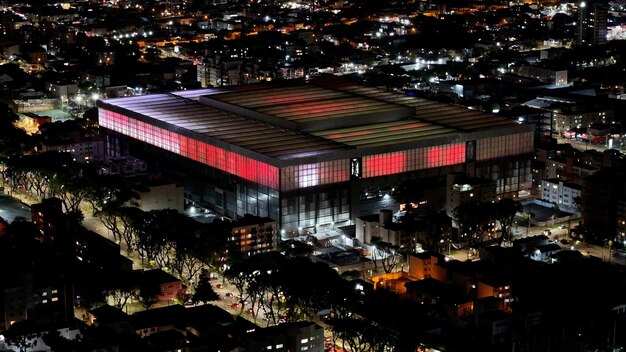MLS Expansion Teams: Where Will the League Expand Next by 2026?

The MLS is actively exploring several promising markets, with San Diego and Las Vegas emerging as frontrunners for new expansion teams by 2026, driven by robust ownership groups, strong fan bases, and viable stadium plans, while Charlotte’s immediate success offers a blueprint for future growth.
The landscape of North American soccer is continually evolving, and a central part of this dynamic growth is the ongoing expansion of Major League Soccer. As the league looks to solidify its footprint, a pivotal question arises for fans and analysts alike: MLS Expansion Teams: Where Will the League Expand Next by 2026?
The MLS Expansion Horizon: A Strategic Overview
Major League Soccer’s growth has been nothing short of spectacular, transforming from a nascent league into a prominent fixture in the global football landscape. This expansion is not merely about adding teams; it’s a meticulously planned strategy to broaden the league’s reach, tap into new fan bases, and leverage significant market potential across the United States and Canada.
The league has consistently pursued a careful, calculated approach to expansion, prioritizing markets that demonstrate a strong alignment with its long-term vision. This involves a rigorous evaluation of various factors, ensuring that each new franchise contributes meaningfully to the league’s overall strength and appeal.
Key Criteria for MLS Expansion
The MLS doesn’t just pick cities at random; there’s a strict set of criteria that potential expansion markets must meet to be considered. These pillars ensure the sustainability and success of new franchises, mitigating risks and maximizing opportunities for growth.
- Strong Ownership Groups: A dedicated, well-financed ownership group with a clear vision for the club’s future is paramount. This includes a commitment to developing local talent and integrating the team into the community.
- Soccer-Specific Stadium Plans: The league places immense importance on a dedicated venue that enhances the fan experience and provides a home for the club’s identity. This often involves significant investment in state-of-the-art facilities.
- Robust Local Market Support: Demonstrable fan interest, from season ticket commitments to local commercial partnerships, signal a viable market. A passionate fan base is vital for creating an electric atmosphere and ensuring long-term engagement.
Beyond these primary factors, the league also considers demographic trends, media market size, and the overall economic health of a prospective city. The goal is to build a diversified portfolio of teams that can thrive both on and off the pitch.
Frontrunners: San Diego and Las Vegas
As the MLS approaches its 30-team target, two cities have consistently emerged at the forefront of the expansion conversation: San Diego and Las Vegas. Both markets present compelling cases, backed by strong bids and unique attributes that appeal to the league’s strategic objectives.
San Diego, with its vibrant cross-border culture and established soccer community, offers a unique opportunity to tap into a rich vein of football enthusiasm. The city’s proximity to Mexico and its diverse population make it an ideal candidate for connecting with a broad fan base.

San Diego’s Compelling Bid
San Diego’s bid is anchored by a solid ownership group and a promising stadium strategy. The city has a proven track record of supporting professional sports, and its deep-rooted soccer culture provides a fertile ground for a new MLS franchise.
- Strong Local Interest: The existing loyal following for lower-division soccer teams in San Diego demonstrates a clear demand for top-tier professional futbol. This pre-existing enthusiasm is a major asset for any new club.
- Ownership & Investment: Led by Mohamed Mansour and the Sycuan Band of the Kumeyaay Nation, the proposed ownership group brings significant financial backing and a commitment to community engagement. Their vision aligns well with the league’s requirements.
- Snapdragon Stadium: The availability of Snapdragon Stadium, a modern facility capable of hosting MLS matches, reduces the immediate need for new construction, allowing for a quicker entry into the league. This ready-to-use venue is a significant advantage.
The city’s diverse demographics and strategic location make it an attractive prospect for expanding the MLS’s reach, particularly among Hispanic communities, who represent a significant portion of its population.
Las Vegas: A Market with Unique Appeal
Las Vegas, known globally as a sports and entertainment hub, offers a different, yet equally compelling, proposition for MLS expansion. The city’s rapid growth and proven ability to host major events appeal to the league’s desire for high-profile markets.
- Entertainment Capital Status: Las Vegas’s reputation as a destination city means potential for drawing in a wider audience, including tourists, for matches. This unique draw could lead to significant commercial opportunities for the league.
- Ownership Stability: The bid from Wes Edens, co-owner of the Milwaukee Bucks and Aston Villa, provides substantial financial backing and experience in professional sports management. This experience is critical for building a successful franchise.
- Potential Stadium Solutions: While a soccer-specific stadium plan is still in development, the commitment from a strong ownership group indicates that a viable solution will be found. The city’s infrastructure supports large-scale construction.
Las Vegas represents a strategic move for the MLS to tap into a burgeoning sports market, capitalizing on its global allure and growing population. The city’s ability to host large-scale events also positions it as a potential venue for future MLS showpieces.
Other Contenders and Emerging Markets
While San Diego and Las Vegas are widely considered the leading candidates, several other cities continue to vie for MLS expansion, presenting strong arguments and demonstrating their local soccer potential. The league maintains an open mind, always seeking the best fit.
Sacramento, with its dedicated fan base and long-standing push for an MLS team, remains a perennial contender. Phoenix, a rapidly growing Sun Belt city, also continues to show interest, bolstered by its expanding population and diverse demographics. The competition underscores the overall strength and appeal of the MLS brand.
Sacramento’s Persistent Bid
Sacramento has a history of strong soccer support, highlighted by the USL’s Sacramento Republic FC’s consistent attendance figures and dedicated fan base. The city’s continuous pursuit of an MLS franchise showcases its unwavering commitment.
- Dedicated Fan Base: Sacramento Republic FC has consistently demonstrated an fervent fan base, selling out matches and creating a vibrant atmosphere. This existing support network is a significant advantage.
- Infrastructure & Community Engagement: The city and its potential ownership groups have invested time and resources into developing detailed stadium plans and engaging with the local community. These efforts reflect a readiness for MLS.
- Regional Opportunity: Positioning an MLS team in Sacramento would further expand the league’s presence in California, a state with immense soccer appeal and a large population. This regional expansion offers strategic benefits.
Despite past setbacks, Sacramento’s resilience and evident passion for the sport keep it in contention, signaling to the league that its market is ready and eager for top-flight soccer.
Phoenix’s Growing Potential
Phoenix, with its booming population and diverse cultural landscape, represents a significant growth market for professional sports. The city’s warm climate and increasing influx of residents further enhance its appeal for an MLS expansion team.
- Population Growth: Phoenix is one of the fastest-growing major cities in the US, providing a continually expanding pool of potential fans. This demographic trend suggests strong future market potential.
- Soccer Enthusiasts: The presence of a strong youth soccer scene and growing interest in international football indicates a nascent, but eager, fan base that could be cultivated. This grassroots support is vital.
- Strategic Location: As a major metropolitan area in the Southwest, Phoenix would provide a crucial bridge between the West Coast and other MLS markets, enhancing regional rivalries and league structure.
While Phoenix’s bid may require more development in terms of specific stadium solutions and ownership, its long-term potential as an MLS market is undeniable, making it a valuable consideration for future expansion rounds.
The Economic Impact of MLS Expansion
The addition of new MLS teams isn’t just about sporting competition; it carries substantial economic implications for host cities and the league as a whole. Each expansion franchise represents a multi-million dollar investment, generating jobs, stimulating local economies, and enhancing civic pride.
From stadium construction to ongoing team operations, the economic ripple effect is significant. This financial benefit is a key factor in the league’s expansion strategy, as it often gains support from local governments and business communities.
Job Creation and Local Investment
An MLS team brings with it a host of new employment opportunities, spanning from administrative staff to game-day operations. The economic benefit extends far beyond the stadium walls, influencing various sectors.
- Direct Employment: Jobs within the club’s front office, coaching staff, and game-day personnel create direct employment opportunities. This core team is essential for daily operations.
- Indirect Employment: Economic activity from tourism, hospitality, and local businesses benefiting from increased foot traffic on match days creates indirect jobs. These include restaurants, hotels, and retail stores.
- Construction & Development: The construction of new soccer-specific stadiums generates significant temporary and permanent jobs in the building and development sectors. These projects often represent large capital infusions.
Beyond employment, the ongoing spending by the team and its personnel, coupled with revenue generated from ticket sales, merchandise, and concessions, circulates through the local economy, providing a consistent boost.
Enhancing City Brand and Tourism
Having an MLS team elevates a city’s profile on both a national and international stage. This enhanced visibility can attract new businesses, residents, and tourists, leading to long-term economic benefits.
- Increased Media Exposure: Broadcasts of matches and sports news coverage highlight the city, showcasing its attractions and amenities to a wider audience. This publicity effectively acts as marketing.
- Tourism Boost: Away fans traveling to watch their teams play contribute to the local tourism industry, filling hotel rooms, dining at restaurants, and visiting local attractions. This influx brings fresh revenue.
- Community Pride & Identity: A professional sports team fosters a sense of collective identity and pride among residents, strengthening community bonds. This intangible benefit contributes to overall quality of life.
The economic impact of MLS expansion is multifaceted, creating a positive feedback loop where investment leads to growth, which in turn attracts further investment, benefiting the entire urban ecosystem.
Challenges and Considerations for Expansion
While MLS expansion presents numerous opportunities, it also comes with its share of challenges and important considerations. The league must carefully navigate potential pitfalls to ensure sustainable growth and maintain competitive balance.
These challenges range from securing viable stadium sites and overcoming local political hurdles to ensuring that new teams can be competitive on the field from day one. The long-term health of the league depends on addressing these issues proactively.
Navigating Stadium Development
Securing a suitable site and funding for a soccer-specific stadium is often the most significant hurdle for expansion bids. These projects are complex, involving land acquisition, zoning approvals, and substantial capital investment.
- Site Selection: Finding a centrally located, accessible site that is large enough for a stadium and surrounding development can be challenging in dense urban areas. Proximity to public transit is often a key factor.
- Funding Models: Financing often involves a mix of private investment, public subsidies, and creative funding mechanisms. Negotiating these agreements can be protracted and politically sensitive.
- Community Opposition: New stadium projects can face opposition from local residents concerned about traffic, noise, and environmental impact. Engaging with the community early is crucial for building consensus.
The success of an expansion bid often hinges on the ability of its ownership group to navigate these intricate development processes and deliver on a clear, well-defined stadium plan.
Maintaining Competitive Balance
As the league expands, a critical consideration is how to integrate new teams without diluting the quality of play or creating a significant imbalance between established and new franchises. This involves thoughtful roster construction and salary cap management.
- Player Acquisition: New teams need to quickly build competitive rosters, often through expansion drafts, trades, and international signings. Attracting quality talent is crucial for on-field success.
- Youth Development: Investing in robust youth academies helps ensure a pipeline of local talent for new teams, contributing to their long-term sustainability and community connection.
- League Structure: The league must continually assess its schedule, playoff format, and competition rules to accommodate new teams while maintaining fair play and exciting rivalries.
Striking the right balance between rapid growth and competitive integrity is a delicate act for the MLS, requiring strategic planning and adaptable policies to ensure sustained success for all its member clubs.
Looking Beyond 2026: The Future of MLS
While the focus is currently on the next wave of expansion expected by 2026, the MLS is known for its ambitious long-term vision. The league continually evaluates opportunities for growth, even beyond its stated 30-team target.
The ongoing success of current expansion teams and the continued rise in soccer’s popularity in North America suggest that the league’s boundaries may continue to push outward, exploring new frontiers and consolidating its position as a major sports league.
Potential for Further Expansion
Even after reaching 30 teams, there remains speculation about whether the MLS will eventually eye further expansion, potentially reaching 32 teams or more. Markets with strong, lingering interest could resurface.
- Undeveloped Markets: Cities like Indianapolis, Detroit, or even San Antonio might present viable long-term options, given their demographics and growing soccer interest. These markets could be explored as the league matures.
- Canadian Growth: While Canada already has three successful MLS teams, the potential for a fourth Canadian franchise in a growing market like Calgary or Edmonton could be explored further down the line.
- Strategic Geographic Fill-ins: The league might look to strategically fill in geographic gaps to minimize travel burdens and foster new regional rivalries, creating a more cohesive league map.
The league’s commitment to strategic growth, combined with the increasing accessibility and appeal of soccer, suggests that the current expansion efforts are part of a much larger, ongoing trajectory of development.
The Evolving Landscape of North American Soccer
The trajectory of MLS expansion is intrinsically linked to the broader evolution of soccer in North America. The success of the World Cup 2026, co-hosted by the US, Canada, and Mexico, is expected to provide another significant boost to the sport’s popularity.
Increased fan engagement, growing talent pools, and rising media rights values all contribute to an environment ripe for continued growth. The MLS is positioning itself to capitalize on these macro trends, cementing its status as a premier sports institution.
| Key Point | Brief Description |
|---|---|
| ⚽ Top Contenders | San Diego & Las Vegas lead bids for next MLS teams by 2026 due to strong ownership and market appeal. |
| 🏟️ Stadium Focus | Soccer-specific stadium plans are a critical requirement for successful expansion bids. |
| 📈 Economic Boost | MLS expansion brings significant job creation and local investment to host cities. |
| 🌱 Sustained Growth | The league looks beyond 2026, considering long-term expansion to reach 32+ teams. |
Frequently Asked Questions About MLS Expansion
The MLS primarily evaluates strong ownership groups, concrete soccer-specific stadium plans, and robust local market support, including passionate fan bases and commercial viability. These elements ensure long-term stability and success for new franchises in their respective communities.
San Diego boasts a vibrant soccer culture and a ready-to-use stadium (Snapdragon Stadium), while Las Vegas offers a rapidly growing sports market and significant entertainment appeal. Both cities have strong, well-financed ownership groups pushing their bids, aligning with league priorities.
MLS expansion generates substantial economic benefits, including direct and indirect job creation from team operations and stadium development. It also boosts local tourism, increases media exposure for the city, and fosters community pride, contributing to overall economic growth.
Key challenges include securing viable soccer-specific stadium sites, navigating complex funding models, overcoming potential community opposition, and ensuring competitive balance among existing and new teams. These factors require careful planning and strategic execution from the league and ownership.
While the immediate focus is on reaching 30 teams, the MLS has a history of ambitious growth. Factors like continued soccer popularity and success of the 2026 World Cup could lead to further expansion beyond this target, potentially exploring new North American markets.
Conclusion
The strategic expansion of Major League Soccer is a testament to its dynamic growth and increasing prominence in the global sports arena. As 2026 approaches, the league’s cautious yet ambitious approach ensures that new additions like San Diego or Las Vegas will not only broaden its geographical reach but also deepen its cultural impact. This ongoing evolution promises an even more exciting and competitive future for soccer in North America, engaging more fans and solidifying its place in the athletic landscape.





